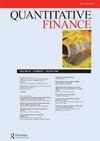A basket half full: sparse portfolios
IF 1.4
4区 经济学
Q3 BUSINESS, FINANCE
引用次数: 0
Abstract
AbstractThe existing approaches to sparse wealth allocations (1) are limited to low-dimensional setup when the number of assets is less than the sample size; (2) lack theoretical analysis of sparse wealth allocations and their impact on portfolio exposure; (3) are suboptimal due to the bias induced by an ℓ1-penalty. We address these shortcomings and develop an approach to construct sparse portfolios in high dimensions. Our contribution is twofold: from the theoretical perspective, we establish the oracle bounds of sparse weight estimators and provide guidance regarding their distribution. From the empirical perspective, we examine the merit of sparse portfolios during different market scenarios. We find that in contrast to non-sparse counterparts, our strategy is robust to recessions and can be used as a hedging vehicle during such times.Keywords: High dimensionalityPortfolio optimizationFactor investingDe-biasingPost-LassoApproximate factor modelJEL Classifications: C13C55C58G11G17 AcknowledgmentsI greatly appreciate thoughtful comments and immense support from Tae-Hwy Lee, Jean Helwege, Jang-Ting Guo, Aman Ullah, Matthew Lyle, Varlam Kutateladze and UC Riverside Finance faculty. I also thank seminar participants at the 14th International CFE Conference (virtual), 2021 Southwestern Finance Association Annual Meeting, and Vilnius University.The author would like to thank the editor and two anonymous referees for their helpful and constructive comments on the paper.Disclosure statementNo potential conflict of interest was reported by the author(s).Notes1 MSCI ITALY, MSCI SPAIN, MSCI PORTUGAL, MSCI FRANCE, MSCI GERMANY, MSCI AUSTRIA, MSCI DENMARK, MSCI FINLAND, MSCI NETHERLANDS, MSCI SWEDEN, MSCI SWITZERLAND, MSCI TURKEY, MSCI CANADA, MSCI BRAZIL, MSCI MEXICO, MSCI COLOMBIA, MSCI ARGENTINA, MSCI PERU, MSCI CHILE, MSCI CHINA, MSCI INDIA, MSCI INDONESIA, MSCI RUSSIA, MSCI JAPAN, MSCI MALAYSIA, MSCI SINGAPORE, MSCI TAIWAN, MSCI SOUTH AFRICA, MSCI AUSTRALIA, MSCI KOREA, MSCI US.2 Since the optimization problem with a cardinality constraint is not convex, we find a solution using the Lagrangian relaxation procedure of Shaw et al. (Citation2008)3 Our empirical results suggest that the unbiased estimator θˆ=((T−p−2)mˆ′Σˆ−1mˆ−p)/T is oftentimes negative even after using the adjusted estimator defined in Kan and Zhou (Citation2007, p. 2906).4 Note that we cannot directly apply Theorem 2.2 of van de Geer et al. (Citation2014) since y needs to be estimated and we first need to show consistency of the respective estimator.5 The results for larger degrees of freedom do not provide any additional insight, hence we do not report them here. However, they are available upon request.6 The conclusions from using daily data are the same as those for monthly returns, hence we do not report them in the main manuscript text. However, they are available upon request.半满的篮子:稀疏的投资组合
摘要现有的稀疏财富分配方法(1)仅限于资产数量小于样本量时的低维设置;(2)缺乏稀疏财富配置及其对投资组合风险敞口影响的理论分析;(3)由于l_1惩罚引起的偏置,是次优的。我们解决了这些缺点,并开发了一种构建高维稀疏投资组合的方法。我们的贡献是双重的:从理论的角度来看,我们建立了稀疏权估计器的预估界,并提供了关于其分布的指导。从实证的角度,我们考察了稀疏投资组合在不同市场情景下的优点。我们发现,与非稀疏策略相比,我们的策略对衰退具有鲁棒性,并且可以在这种时期用作对冲工具。关键词:高维投资组合优化因子投资去偏化后套期近似因子模型jel分类:C13C55C58G11G17感谢来自Tae-Hwy Lee, Jean Helwege, Jang-Ting Guo, Aman Ullah, Matthew Lyle, Varlam Kutateladze和加州大学河滨市金融学院的宝贵意见和大力支持。我还要感谢第14届CFE国际会议(虚拟)、2021年西南金融协会年会和维尔纽斯大学的与会者。作者要感谢编辑和两位匿名审稿人对本文的帮助和建设性意见。披露声明作者未报告潜在的利益冲突。注1 MSCI意大利,MSCI西班牙,MSCI葡萄牙,MSCI法国,MSCI德国,MSCI奥地利,MSCI丹麦,MSCI芬兰,MSCI荷兰,MSCI瑞典,MSCI瑞士,MSCI土耳其,MSCI加拿大,MSCI巴西,MSCI墨西哥,MSCI哥伦比亚,MSCI阿根廷,MSCI秘鲁,MSCI智利,MSCI中国,MSCI印度,MSCI印度尼西亚,MSCI俄罗斯,MSCI日本,MSCI马来西亚,MSCI新加坡,MSCI台湾,MSCI南非,MSCI澳大利亚,MSCI韩国,由于具有cardinality约束的优化问题不是凸的,我们使用Shaw et al. (Citation2008)的拉格朗日松弛过程找到了一个解决方案。3我们的经验结果表明,即使使用Kan和Zhou (Citation2007, p. 2906)中定义的调整估计量,无偏估计量θ - =((T−p−2)m - ' Σ - 1m - p)/T也经常是负的注意,我们不能直接应用van de Geer et al. (Citation2014)的定理2.2,因为y需要估计,我们首先需要证明各自估计量的一致性更大自由度的结果没有提供任何额外的见解,因此我们不在这里报告它们。但是,我们可以应要求提供使用日数据得出的结论与使用月数据得出的结论相同,因此我们没有在主要稿件中报告。但是,它们可以根据要求提供。
本文章由计算机程序翻译,如有差异,请以英文原文为准。
求助全文
约1分钟内获得全文
求助全文
来源期刊

Quantitative Finance
社会科学-数学跨学科应用
CiteScore
3.20
自引率
7.70%
发文量
102
审稿时长
4-8 weeks
期刊介绍:
The frontiers of finance are shifting rapidly, driven in part by the increasing use of quantitative methods in the field. Quantitative Finance welcomes original research articles that reflect the dynamism of this area. The journal provides an interdisciplinary forum for presenting both theoretical and empirical approaches and offers rapid publication of original new work with high standards of quality. The readership is broad, embracing researchers and practitioners across a range of specialisms and within a variety of organizations. All articles should aim to be of interest to this broad readership.
 求助内容:
求助内容: 应助结果提醒方式:
应助结果提醒方式:


